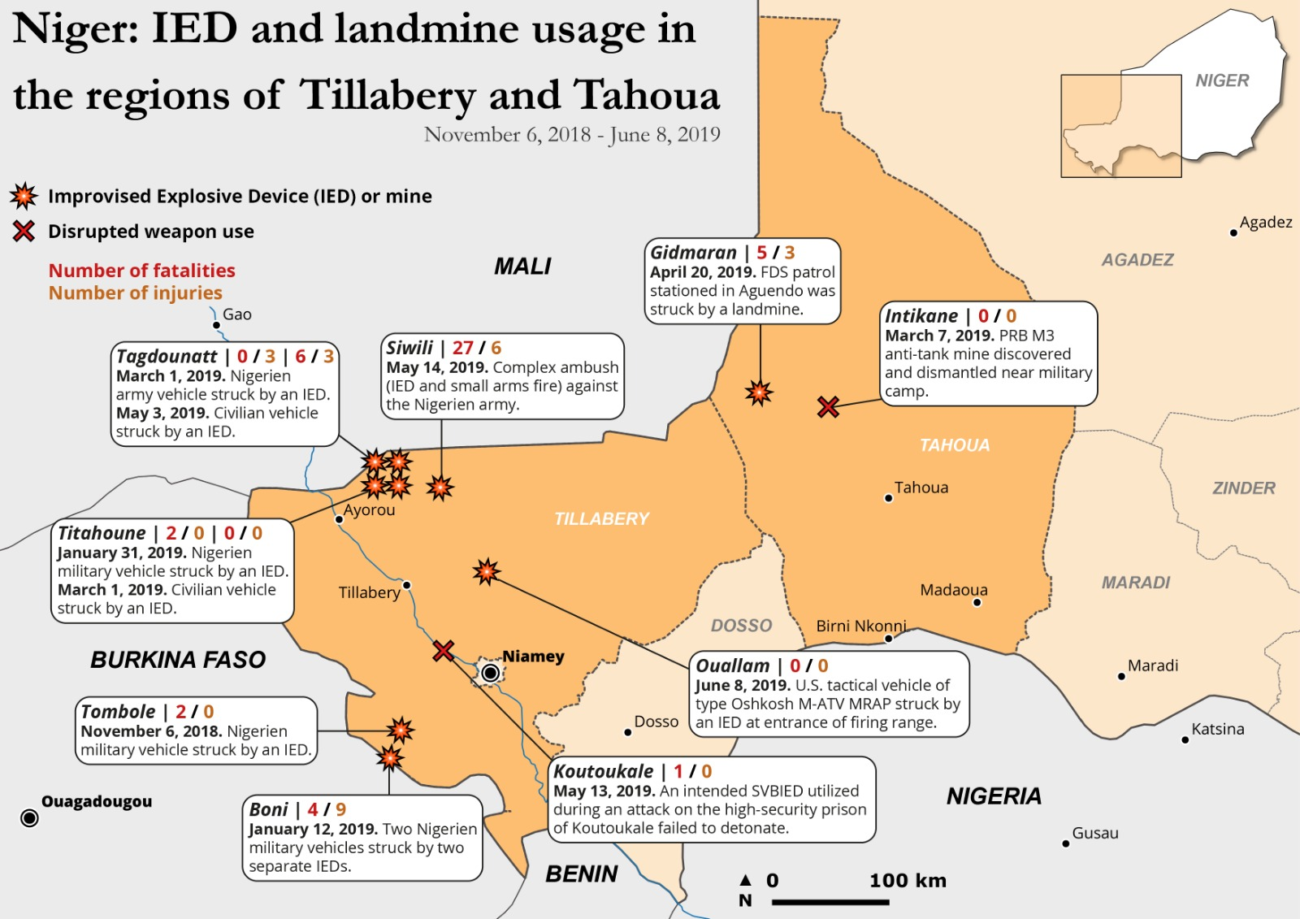This report is also available in French.
Over the past seven months, armed groups across Western Niger have executed a series of IED attacks – a first in the area’s ongoing insurgency. The increasing use of IEDs by the Islamic State in the Greater Sahara (ISGS) in the Tillabery and Tahoua regions of Niger indicates that the region’s insurgency is escalating and globalizing, following a similar trajectory to the conflicts in Burkina Faso and in Mali. The new and sustained use of IEDs – as well as accompanying strategic shifts – implies that hyper-localized groups are increasingly coordinating, both with each other and (in the case of ISGS) with the global core. The geographic spread of this IED campaign also indicates that this newly-acquired tactical expertise is spread across multiple groups. A shift towards IED use in the neighboring countries of Burkina Faso and Mali preceded a new focus on territorial contestation – suggesting that these developments can likely be similarly expected in Niger moving forward.
Explosive devices are not a novelty in Niger: armed groups widely used landmines during the 2007-2009 rebellion, and Islamic State West Africa Province (ISWAP) and Boko Haram militants have deployed IEDs in the Diffa Region in the context of the Lake Chad insurgency. However, IEDs are a new feature of the insurgency in the regions of Tillabery and Tahoua — and their sudden onset indicates a shift in ground reality beyond the natural evolution of ISGS capabilities.
This IED campaign began seven months ago and has remained consistent – indicating that IED usage is an important and lasting trend (see figure above). Additionally, the lethality of these IED attacks demonstrates the campaign’s capacity to shift ground realities substantially. A recent ambush against the Nigerien army involving an IED constituted the deadliest attack ever recorded in western Niger (ACLED, 2019), and an IED attack targeting U.S. Special Forces near Ouallam (MENASTREAM, 2019) represented the first confirmed IED attack targeting U.S. forces in Niger. In addition to the successfully executed IED attacks, an intended suicide vehicle-borne improvised explosive device (SVBIED) failed to detonate amidst an attempted prison break targeting the Koutoukale high-security prison, located approximately 35 kilometers northwest of the capital Niamey. In total, at least nineteen people have been killed and eighteen injured as the direct result of these explosive devices. The sudden onset, consistent usage, and increase in lethality indicate that this IED campaign is a clear step-change for ISGS in the region.
This step-change itself indicates increasing coordination between ISGS and other regional and global organizations. The IED campaign corresponds with ISGS’s shift towards the global through the re-established connection with the parent organization Islamic State (IS) central. Additionally, ISGS has been incorporated into ISWAP as broadcasted in IS’s media campaign – potentially engendering growing ties between ISGS and ISWAP – though this connection has yet to be substantiated on the operational level.
This IED campaign corresponds to increased ties between ISGS and IS central, but inter-militant group movement also spurred this change in tactics. Since mid-2017, Jama’ah Nusrat al-Islam wal-Muslimin (JNIM) commanders experienced in militant tradecraft have begun migrating to ISGS. This movement has progressively shifted ISGS’s previous tactics – including armed ambushes and raids – toward complex ambushes, SVBIED and IED attacks. The proliferation and spread of IED usage has followed in the footsteps of the expanding subregional insurgency (ACLED, 2019), where regional Islamic State and Al Qaeda franchises have deepened cooperation (RFI, 2019; Le Monde, 2019).
The geographic scope of the IED campaign demonstrates that this newly acquired tactical expertise is not limited to a single ISGS cell. In western Niger, detonations have occurred in five departments of the regions of Tillabery and Tahoua (see graph below). This indicates that several ISGS cells are capable of utilizing anti-tank mines, rudimentary victim-operated (pressure plate) devices composed by wired mortar and artillery shells, and more advanced remote-controlled devices. Similarly, the incidents in Ouallam and Koutoukale suggest that ISGS have begun deploying this tactic closer to Niamey, an increase in ISGS’s capacity and geographic reach. This spread mimics the trajectory of the insurgency in neighboring countries. It follows a pattern similar to an IED campaign in Burkina Faso in August 2017, which began in Soum Province, and subsequently spread to nine others. While IEDs are commonly used by other IS branches in the wider region, the IED trend in Niger mimics more closely the modus operandi of JNIM and ISGS branches in Mali and Burkina Faso.
The increased use of IEDs in Niger has several implications for the trajectory of the insurgency. Non-state armed groups are diversifying and adapting their modes of engagement with their adversaries. Moving forward, it is likely that the insurgency in Niger will dramatically escalate, not because of the IEDs, but because of what they imply about the increasing freedom, tactical expertise, and connections of the groups operating there. Additionally, other militant activities, not just IEDs, indicate that groups like ISGS and JNIM will increasingly contest territory in Western Niger. There is also the potential for further mutation and escalation of the insurgency through the solidification of nexuses between IS branches in the region.
© 2019 Armed Conflict Location & Event Data Project (ACLED). All rights reserved.







